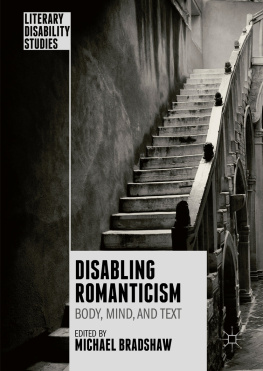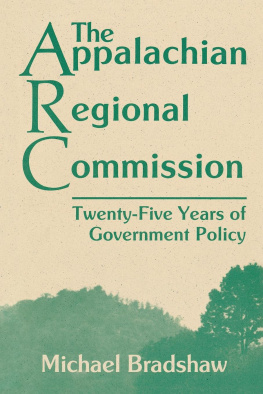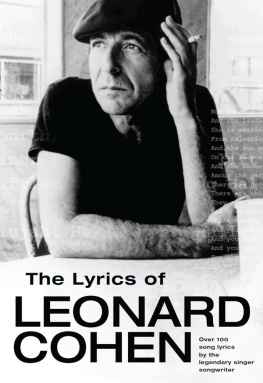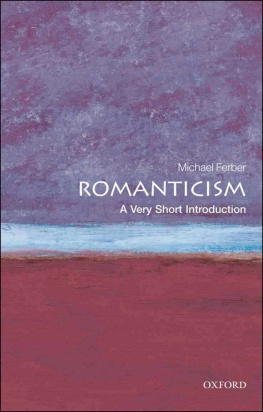Resurrection Songs
For Desdemona and Jacob
Resurrection Songs
The Poetry of Thomas Lovell Beddoes
Michael Bradshaw
First published 2001 by Ashgate Publishing
Reissued 2018 by Routledge
2 Park Square, Milton Park, Abingdon, Oxon OX14 4RN
711 Third Avenue, New York, NY 10017, USA
Routledge is an imprint of the Taylor & Francis Group, an informa business
Copyright Michael Bradshaw 2001
The author has asserted his right under the Copyright, Designs and Patents Act, 1988, to be identified as the author of this work.
All rights reserved. No part of this book may be reprinted or reproduced or utilised in any form or by any electronic, mechanical, or other means, now known or hereafter invented, including photocopying and recording, or in any information storage or retrieval system, without permission in writing from the publishers.
Notice:
Product or corporate names may be trademarks or registered trademarks, and are used only for identification and explanation without intent to infringe.
Publisher's Note
The publisher has gone to great lengths to ensure the quality of this reprint but points out that some imperfections in the original copies may be apparent.
Disclaimer
The publisher has made every effort to trace copyright holders and welcomes correspondence from those they have been unable to contact.
A Library of Congress record exists under LC control number: 00030600
ISBN 13: 978-1-138-63687-3 (hbk)
ISBN 13: 978-1-138-63689-7 (pbk)
ISBN 13: 978-1-315-20545-8 (ebk)
Figure 3.1
Vesalius, De Humani Corporis Fabrica, 2nd edition (1555): 1st, 2nd and 3rd woodcuts of the skeleton, Book I |
Figure 3.2
Vesalius, De Humani Corporis Fabrica, 2nd edition (1555): 1st, 2nd, 11th and 12th woodcuts of the muscles, Book II |
Figure EP. 1
Hans Holbein, The Dance of Death sequence (1538):
The Expulsion
The Consequences of the Fall
The Husbandman |
The aim of this series is to reflect, develop and extend the great burgeoning of interest in the nineteenth century that has been an inevitable feature of recent decades, as that former epoch has come more sharply into focus as a locus for our understanding not only of the past, but also of the contours of our modernity. Though it is dedicated principally to the publication of original monographs and symposia in literature, history, cultural analysis, and associated fields, there will be a salient role for reprints of significant texts from, or about, the period. This, we believe, distinguishes our project from comparable ones, and means, for example, that in relevant areas of scholarship we both recognize and cut innovatively across such parameters as those suggested by the designations 'Romantic' and 'Victorian'. We welcome new ideas, while valuing tradition. It is hoped that the world which predates yet so forcibly predicts and engages our own will emerge in parts, as a whole, and in the lively currents of debate and change that are so manifest an aspect of its intellectual, artistic and social landscape.
Vincent Newey
Joanne Shattock
University of Leicester
Readers usually remember their first acquaintance with Thomas Lovell Beddoes. In 1989 I found this poem quite by accident, while looking for something else:
Thread the nerves through the right holes,
Get out of my bones, you wormy souls.
Shut up my stomach, the ribs are full:
Muscles be steady and ready to pull.
Heart and artery merrily shake
And eyelid go up, for we're going to wake.
His eye must be brighter - one more rub!
And pull up the nostrils! his nose was snub.
It was immediately embarrassing to think I had never read Beddoes before. I still feel there is nothing quite like it, certainly in the literature of his own time. So short, and so compelling, and breathing such comic recklessness, 'Resurrection Song' is hard to forget. The modish macabre of the imagery is married to an anatomist's love of precision, and yet also to wild satirical laughter. But it is the placement of the poem in time which makes its effrontery so striking: it dramatizes the very moment of resurrection, as a stolid corpse is creakingly jarred back into life and motion. Standing on the infinitesimal borderline between dead meat and living flesh, the poem is strongly felt as a dramatic moment, and yet expresses no reverence for the resurrection body, or for the immortal state. The resurrection song is defined by its temporal and dramatic setting, and yet affects derision for the process of resurrection, as for the supposedly blessed state which it inaugurates. It therefore pulls both into and out of its bizarre theatrical context, embodying in miniature both the double life of the fragment and the alienating contradictions of immortality. There will be further discussion in below where it will be observed that 'Resurrection Song' is a stranded poem, having been suppressed by Beddoes from the drama Death's Jest-Book, and relegated to the paratext; the poem's textual status therefore further dramatizes the sense of the fragmentary in these lines on the stitching together of a broken body.
This study will attempt to bring the two principal discourses of this poem - immortality and fragmentation - together. I will argue that they are both pervasive in Beddoes's writing, complementing and interrogating each other. Examining the relationship between the theme of human immortality and textual structure, the study foregrounds the phenomenon of broken form will all gravitate round the Jest-Book.
The introductory chapter will develop some opening remarks on the implications of immortal life, and go some way to providing a theoretical base for what follows. It will deal particularly with the function of immortality in breaking up and problematizing the human subject, and its strong conduciveness to convergence and collapse in structural configurations of meaning. Discussion of some traditions of thought on immortality establishes the general connection with the fragmenting of identity, which is then demonstrated in the intertextual patterns of Beddoes's early dramas in returns to the disturbance of identity, and considers breakage, reflection and doubling in Beddoes's political images. This final chapter considers the metaphorical application of tropes of resurrection and immortality to political and literary regeneration, examining Beddoes's use of quotation and revision of his fragmentary texts as an expression of his own disappearance and death.
below, the texts themselves provide a singularly aggressive and destructive vocabulary to represent the vagaries of reputation, in such a way as almost to collude with their own marginality.
Especially in the light of the remarks above, I would like to express my gratitude to Joanne Shattock and Vincent Newey for supporting a rare long publication on Beddoes. I gratefully acknowledge the permission of Edwin Mellen Press to include revised material from my essay 'Resurrecting Thomas Lovell Beddoes' in The Influence and Anxiety of the British Romantics: Spectres of Romanticism, edited by Sharon Ruston (Lampeter: Mellen, 2000); and also the permission of Agenda magazine to rework some of my article 'Beddoes and the Poetics of Fragmentation' ( Agenda, 37, 2-3 [1999], 264-80) for a section of .











